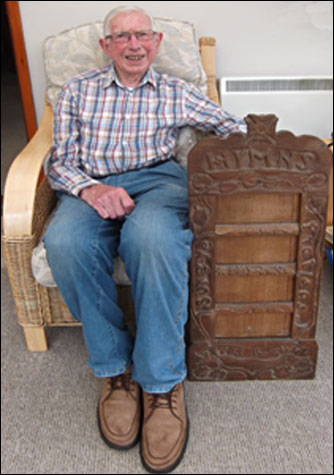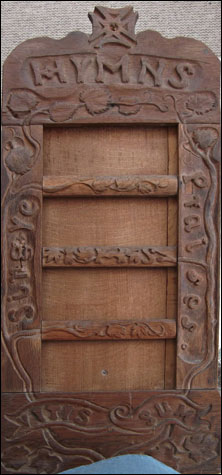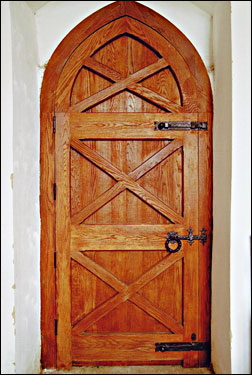|
Wolverton Express 27th July 1965

The chancel of Cosgrove SS Peter and Paul church has recently had a £2000 facelift, including a new oak ceiling. Tiles on the roof have been replaced and the walls and masonry repaired. The cost of the roof and the repair and re-decoration has been twice as much as first estimated, and although £1000 has already been paid the church members are now faced with finding another £1044.
The gift day will be held in the parish in October and members of the Wolverton Methodist church have offered to help. The Methodist Church choir under its conductor, Mr. Arnold Jones, will be giving a concert in aid of the Cosgrove Church Restoration Fund in the church on September 11. Mr. Lewis Clarke will be the accompanist and will also give organ and harpsichord solos. Other solos will by Mrs. Kathleen Jones (soprano) and Robert Jones (recorder).
While working on the inside wall workmen found a niche to the right of the altar which had been concealed for many years. The rector, the Rev. AC Barker, believes that the niche, which shows evidence of having an iron grating in front of it, may have been used for the Reserve Sacrament before the Reformation
Hymn Board “In Memoriam” Inscription.
An old Hymn Board hangs on a pillar between the Nave and the Aisle as in the picture above left. When this was taken down for restoration the inscription below was revealed:
In Memoriam
JG 1869 - EG 1872 - WM 1860

The 2008 churchyard project lists the Grahams and William Moorsom as being buried in adjoining plots near to the “obelisk” memorial of Joseph Atkinson. Elizabeth Graham was born Elizabeth Moorsom in Whitby, Yorkshire around 1814 and William Moorsom was her brother, the two being the children of Richard Moorsom, brother of Sir Robert Moorsom of Trafalgar.
Sir Robert Moorsom's nephew William Moorsom (1816–1860), naval officer, was ‘Shell Moorsom’, inventor of the percussion fuse. Born on 7 February 1816 at Airy Hill, Whitby, the son of Richard Moorsom (1758–1831), shipowner and marine merchant, and his wife, Barbara, née Craig (1780–1832), he attended the Royal Naval College, Portsmouth (1829–30), gaining the first medal, and passed the lieutenant's examination in June 1835 but was not commissioned lieutenant until 1842, with the Cornwallis in the First Opium War. In 1854, in the Crimean War, he was appointed captain of the Firebrand but served ashore with the naval brigade, having a large share in its organization. Wounded and twice mentioned in dispatches, he was a CB, a chevalier of the Légion d'honneur and a knight second class of the Mejidiye. Known as Black Will when shaving was compulsory in the navy he was, on his return from the Black Sea, ‘the first captain who had the temerity to invade the sacred precincts of the Admiralty with hirsute “fixings”’, to be met with ‘the cutting remark: “Horseguards next door!”’ (Clowes, 6.211–12).
William Moorsom was described fifty years afterwards as ‘an officer of high scientific attainments’ (Garbett, 30). His ‘Moorsom percussion fuze’ of 1850, though obsolete fifteen years later, was the first satisfactory metal percussion fuse for the navy. He also invented the ‘Director’, an instrument for concentrating a ship's broadside, perfected and in use forty-five years later.
He was the author of Remarks on Concentrating the Fire of Ships' Guns (1846), Suggestions for the Organisation and Manoeuvres of Steam Fleets (1854), and Remarks on the Construction of Ships of War and the Composition of War Fleets (1857). In 1857 he was appointed to the screw frigate Diadem in which, while recovering from a severe attack of smallpox, he was sent to the West Indies and to Vera Cruz, where he contracted a fever. On his return to England he was compelled to resign his command in October 1859.
He died suddenly on 4 February 1860 at Vernon Terrace, Brighton, Sussex, and was buried a week later at Cosgrove, Northamptonshire, where there is a stained-glass window to his memory in the church.

In Memory of Captain William Moorson RN CB
Born at Whitby February 7th 1816 Died Feb 4th 1860
28 June 1830 Entered Navy
29 March 1842 Lieutenant
8 March 1848 Commander
14 March 1851 Captain
29 August 1854 Captain in Firebrand, Black Sea, Moorsom serving ashore with the Naval Brigade, during the Russian War
13 August 1855 to 5 January 1856 Captain in Leander, flagship of Rear-Admiral Charles Howe Fremantle, Black Sea, during the Russian War
24 January 1856 to 27 September 1856 Captain in Eurotas (from commissioning at Sheerness until paying off at Sheerness), Sheerness (and the 1856 Royal Naval review)
19 August 1857 to October 1859 Captain in Diadem (from commissioning at Portsmouth), Channel squadron, then West Indies (until Moorsom was invalided)
Elizabeth Graham was born Elizabeth Moorsom and was William's sister.
Foundation of Mrs Elizabeth Graham
By an Indenture dated 22nd March 1862 and made between the Rev John Graham, then Rector of Cosgrove and the then Churchwardens of the one part and Mrs Elizabeth Graham of the other part, after reciting that Mrs Elizabeth Graham had out of her own separate monies purchased the sum of £166 13s 4d. Consolidated 3 per cent annuities and had caused the same to be transferred into the names of the Rector and Churchwardens, it was declared that the said sum of stock should be held by the Rector and Churchwardens on trust to apply the dividends thereof for the maintenance and benefit of the National School in Cosgrove in such manner as they should from time to time think proper, provided always that in case the said National School should at any time thereafter cease to be carried on or should be managed or conducted in any other way or for any other purpose than as a Church of England school for the benefit of the children of the labouring classes in the said parish of Cosgrove, then and in such case the trust fund should be held in trust for the said Elizabeth Graham, her executors, administrators and assigns: and it was agreed that, on the death of the said John Graham, and on the death of his successors, Rectors of Cosgrove, the trust fund should be so transferred that it should stand in the names of the Rector and Churchwardens for the time being, the expense of such transfer being paid out of the dividends of the trust fund and not out of the corpus.
Cosgrove National School is comprised in two deeds, dated respectively 19th April 1844 and 18th February 1870, and is now regulated by a scheme of the Charity Commissioners, dated 9th April 1875. The scheme provide (inter alia) that the School shall be at all times open to the Inspection of His Majesty’s Inspector of Schools, and shall be in union with, and conducted according to the principles of the National Society. The School has accommodation for 98 children and an average attendance of 71.
The annual income, amounting to £4 3s 4d, has been applied towards the maintenance of the School. The Stock is standing in the name of Messrs H Grant Thorold and F D Bull.
John Graham was rector of Cosgrove between 1835 and 1869, a period which, as elsewhere, saw the establishment of a National school and the restoration of the parish church, (fn. 78) although he seems not to have made the same mark on either the parish or wider church life in the district as, say, H. J. Barton at Wicken, Barwick Sams at Grafton Regis, or W.H. Newbolt at Paulerspury.
Northampton Mercury - Saturday 08 August 1835
The Rev. John Graham, M.A. Fellow of Queen's College, Cambridge, has been instituted by the Lord Bishop of Peterborough, to the Rectory of Cosgrove, in this county, vacant by the death of the Rev. Henry Longueville Mansel, on the presentation of Mrs. H. L. Mansel.
The Census of 1851 reveals that Elizabeth and John Graham had three sons and a daughter, all born in the Rectory at Cosgrove.
|
John
|
GRAHAM
|
head
|
married
|
49
|
|
M A Rector of Cosgrove
|
Carlisle
|
|
Elizabeth
|
GRAHAM
|
wife
|
married
|
|
36
|
|
Whitby
|
|
Arthur Robt
|
GRAHAM
|
son
|
|
13
|
|
|
Cosgrove
|
|
Emily M
|
GRAHAM
|
daughter
|
|
|
9
|
|
Cosgrove
|
|
Henry L
|
GRAHAM
|
son
|
|
7
|
|
|
Cosgrove
|
|
Malcolm R
|
GRAHAM
|
son
|
|
5
|
|
|
Cosgrove
|
|
|
|
|
The Hymn board was mended in 2016 by David Blunden, of Old Stratford, who also made the memorial stool dedicated to Basil Richards. David trained with Betts and Faulkner, a local building company, and David’s maker’s mark is stamped on the underside of the stool.
During this restoration the memorial inscription on the reverse of the board was revealed as well as a provenance note to the effect that the board was carved by Harry Johnson of Cosgrove in 1911 or 1912. Harry’s story can be found here.
|
|





















